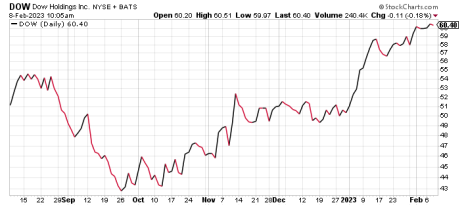Oftentimes, I find that investors overcomplicate their investment approach, searching for the latest and greatest strategies only to find frustration when their newfound approach fails.
Well, that’s simply not the case for passive investment strategies like the Dogs of the Dow, Ray Dalio’s All-Weather strategy and David Swensen’s Yale Endowment strategy. Each passive strategy has a long-term track record of success. In fact, each strategy has consistently outperformed its respective benchmarks over the long term. And it’s long-term performance that truly matters. This makes them ideal to pair with my favorite overlooked options strategy. For example, let’s take a closer look at the performance of the Dogs and Small Dogs of the Dow.
Starting with 2022, the Dogs of the Dow gained just over 2% on average in 2022. Doesn’t sound like much but the performance was way ahead of the S&P 500’s nearly 20% loss and much better than the 8.8% decline by the benchmark Dow Jones.
What about over the long term?
According to DogsoftheDow.com, “the data shows that, over the long term, the performance of the Dogs of the Dow and the Small Dogs of the Dow has been impressive. For example, since the turn of the century, Dogs of the Dow has had an average annual total return of 9.9% while Small Dogs of the Dow did even better with an average annual total return of 12.1%. Noticeably better than the Dow Jones Industrial Average … and notable considering that the time period included the dot-com bust, a historic financial crisis, a pandemic-induced economic shutdown, and the bear market of 2022.
And that’s my goal within Cabot Options Institute’s Fundamentals—to provide simple, conservative investment strategies, like the Dogs and Small Dogs of the Dow, All-Weather and Yale Endowment that have a long-term track record of success but with a twist. I like to wrap conservative options strategies around each proven investment strategy.
[text_ad]
Because there aren’t bonus points for complicated strategies, or taking aggressive, highly volatile approaches. It all comes down to long-term returns, but returns based on calculated risk. And that’s what the investment approaches in my Fundamentals service provide … strategies with a long-term track record of success.
The Overlooked Options Strategy – Poor Man’s Covered Calls
Also known as long call diagonal spreads, a poor man’s covered call is similar to a traditional covered call strategy, with one exception in the mechanics. Rather than buying 100 or more shares of stock, an investor simply buys an in-the-money LEAPS call and sells a near-term out-of-the-money call against it.
By using a poor man’s covered call approach, we are able to save 65% to 85% of the capital required to buy 100 or more shares of stock. But more importantly, we are able to lower our cost basis every 30 to 60 days by continually selling calls against our LEAPS position.
LEAPS, or long-term equity anticipation securities, are basically options contracts with an expiration date longer than one year. LEAPS are no different from short-term options, but the longer duration offered through a LEAPS contract gives an investor the opportunity for long-term exposure.
The positions in the portfolios are delta positive. This simply means that each position is inherently bullish, and my goal is to make sure each position remains delta positive at all times. And even though the positions are delta positive, we still have the opportunity to make money if the market remains flat or even drops slightly, but the portfolio does best when the stocks that reside in the portfolio trend higher.
How to Initiate Your First Trade (Applicable to All of Our Strategies)
There are numerous ways to approach poor man’s covered calls. My preference is to use LEAPS that have at least two years left until expiration. Let’s focus on the step-by-step mechanics of the trade. Below is one of the Dogs of the Dow trades I placed at the onset of 2023 and should give you great insight into how we initiate a trade using a poor man’s covered call strategy.
For example, let’s take a look at one of the Small Dogs of the Dow stocks, Dow Inc. (DOW).
As you can see in the chart below the stock is currently trading for 60.40.
Now, if we followed the route of the traditional covered call we would need to buy at least 100 shares of the stock. At the current share price, 100 shares would cost $6,040. Certainly not a crazy amount of money. But just think if you wanted to use a covered call strategy on, say, a higher-priced stock like Apple (AAPL), Microsoft (MSFT) or even an index ETF like SPDR S&P 500 ETF (SPY). For some investors, the cost of 100 shares can be prohibitive, especially if diversification amongst a basket of stocks is a priority. Therefore, a covered call strategy just isn’t in the cards…and that’s unfortunate.
So, it’s worth repeating, with a poor man’s covered call strategy you can typically save 65% to 85% of the cost of a covered call strategy. Again, rather than purchase 100 shares or more of stock, we only have to buy one LEAPS call contract for every 100 shares we wish to control.
As I said before, my preference is to buy a LEAPS contract with an expiration date of around two years. Some options professionals prefer to only go out 12-16 months, some even less, but I prefer the flexibility the two-year LEAPS offers.
Again, I want to go out roughly two years in time. The January 19, 2025, expiration cycle with 709 days left until expiration is the longest-dated expiration cycle and would be my choice. And when my LEAPS reach 10-12 months left until expiration, I then begin the process of selling my LEAPS and reestablishing a position with approximately two years left until expiration.
Once I have chosen my expiration cycle, I then look for an in-the-money call strike with a delta of around 0.80.
When looking at Dow’s option chain I quickly noticed that the 42.5 call strike has a delta of 0.81. The 42.5 strike price is currently trading for approximately $19.40. Remember, always use a limit order. Never buy an option at the ask price, which in this case is $19.90.
So, rather than spend $6,040 for 100 shares of DOW, we only needed to spend $1,940. As a result, we saved $4,200 or 69.5%. Now we have the ability to use the capital saved to diversify our premium amongst other securities if we so choose.
After we purchase our LEAPS call option at the 42.5 strike, we then begin the process of selling calls against our LEAPS.
My preference is to look for an expiration cycle with around 30-60 days left until expiration and then aim for selling a strike with a delta ranging from 0.20 to 0.40, or a probability of success between 60% and 85%.
As you can see in the options chain below, the 62.5 call strike with a delta of 0.30 falls within my preferred range.
We could sell the 62.5 call option for roughly $0.74. The premium collected is 4.0% over 37 days or approximately 36% in premium collected annually. If we were to use a traditional covered call our potential return on capital would be less than half, or 1.2%.
And remember, the 4.0% is just the premium return; it does not include any increases in the LEAPS contract if the stock pushes higher. Moreover, we can continue to sell calls against our LEAPS position for another 8 – 12 months, thereby generating additional income or lowering our cost basis even further.
An alternative way to approach a poor man’s covered call, if you are a bit more bullish on the stock, is to buy two LEAPS for every call sold. This way you can benefit from the additional upside past your chosen short strike, yet still participate in the benefits of selling premium.
Regardless of your approach, you can continue to sell calls against your Dogs of the Dow LEAPS as long as you wish. Whether you hold a position for one expiration cycle or 12, poor man’s covered calls give you all the benefits of a covered call for significantly less capital.
So far in 2023 shares of DOW are up roughly 15%, while our poor man’s covered call approach has DOW up 29.7%. In fact, the entire Small Dogs of Dow portfolio (using our Poor man’s covered call strategy) is up over 15% since 2023 began.
[author_ad]



